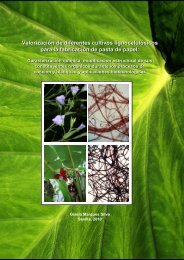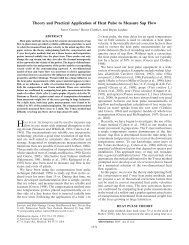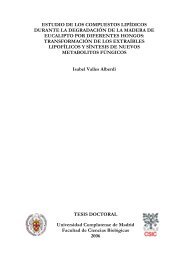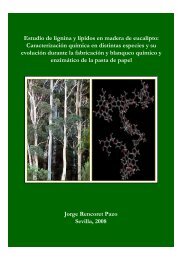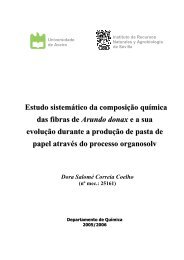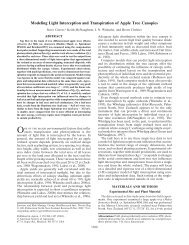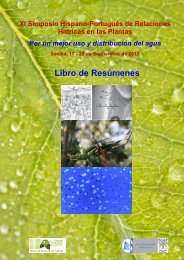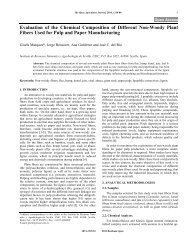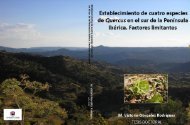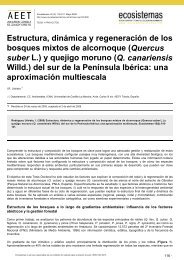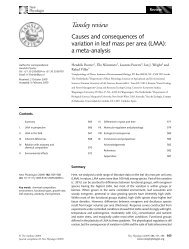Caracterización química de fibras de plantas herbáceas utilizadas ...
Caracterización química de fibras de plantas herbáceas utilizadas ...
Caracterización química de fibras de plantas herbáceas utilizadas ...
You also want an ePaper? Increase the reach of your titles
YUMPU automatically turns print PDFs into web optimized ePapers that Google loves.
4. Resultados y discusión<br />
fragmentos a [M-18] + , [M-59] + y [M-77] + , ajustándose sobre todo al compuesto B,<br />
al estar presente también los fragmentos a m/z 427, 401, 383 y 125 (Nakamura et<br />
al., 1997), diferenciándose sólo por la ausencia <strong>de</strong>l ión molecular a m/z 460, en el<br />
espectro. El espectro <strong>de</strong> masas <strong>de</strong> cabraleadiol m/z 460 [M] + (2), 445 [M-18] + (11),<br />
427 [M-33] + (15), 401 [M-59] + (40), 383 [M-77]+ (85), 191(68), 143(100), 125(85)<br />
(Nakamura et al., 1997). El cabraleadiol ha sido i<strong>de</strong>ntificado en varias <strong>plantas</strong><br />
(Hisham et al., 1996, Nakamura et al., 1997, Rouxc et al., 1998, Qiu et al., 2001).<br />
En la Figura 60 se muestran las estructuras <strong>de</strong> la capsugenina y el cabraleadiol.<br />
Estudiando ambos perfiles <strong>de</strong> fragmentación po<strong>de</strong>mos <strong>de</strong>terminar que los<br />
compuestos A y B presentes en el yute son <strong>de</strong>l tipo epoxidammarano con una<br />
ca<strong>de</strong>na lateral hidroxiisopropilmetiltetrahidrofurano.<br />
OH<br />
OH<br />
(a)<br />
OH<br />
O<br />
(b)<br />
O<br />
HO<br />
CH 2 OH<br />
HO<br />
Figura 60. Estructuras <strong>de</strong> la capsugenina (a) y el cabraleadiol (b).<br />
4.2.2.5. Fibras <strong>de</strong> sisal<br />
El extracto lipídico <strong>de</strong> las <strong>fibras</strong> <strong>de</strong> sisal es <strong>de</strong>l 0,5% (Tabla 2). El cromatograma<br />
<strong>de</strong>l extracto lipídico <strong>de</strong> las <strong>fibras</strong>, sin <strong>de</strong>rivatizar, se muestra en la Figura 61. La<br />
composición <strong>de</strong>tallada <strong>de</strong> los compuestos i<strong>de</strong>ntificados se muestra en la Tabla 5.<br />
Las familias <strong>de</strong> compuestos más abundantes en estas <strong>fibras</strong> son n-ácidos grasos<br />
(20%), seguida <strong>de</strong> n-alcoholes <strong>de</strong> ca<strong>de</strong>na larga (20%), esteroles (11%), n-alcanos<br />
(11%), ésteres <strong>de</strong>l ácido ferúlico con n-alcoholes (10%) y ω-hidroxiácidos (10%).<br />
101



